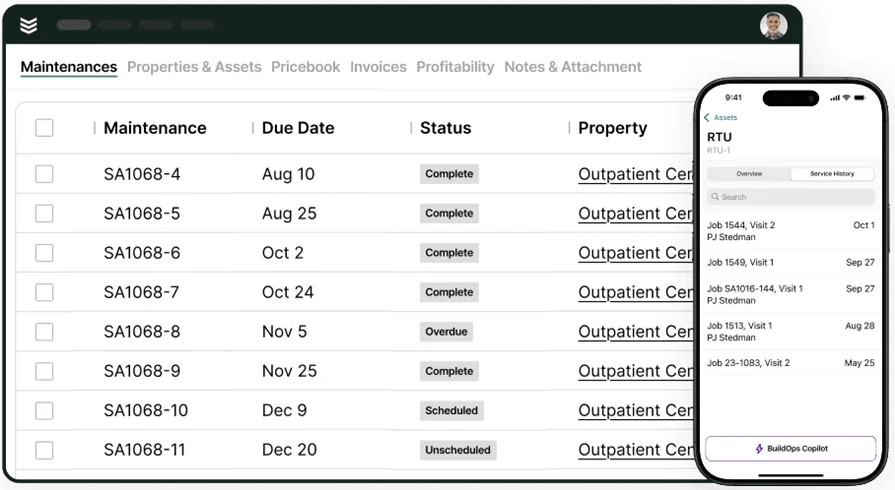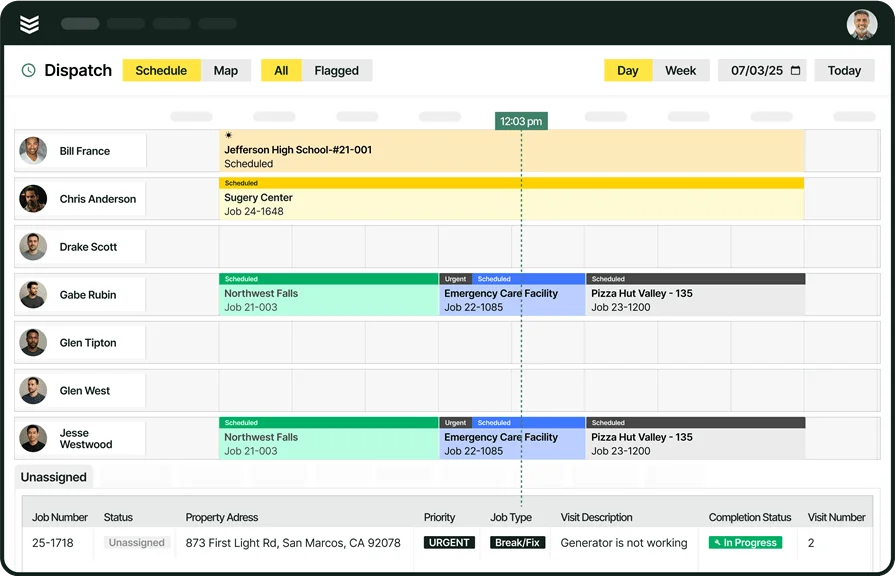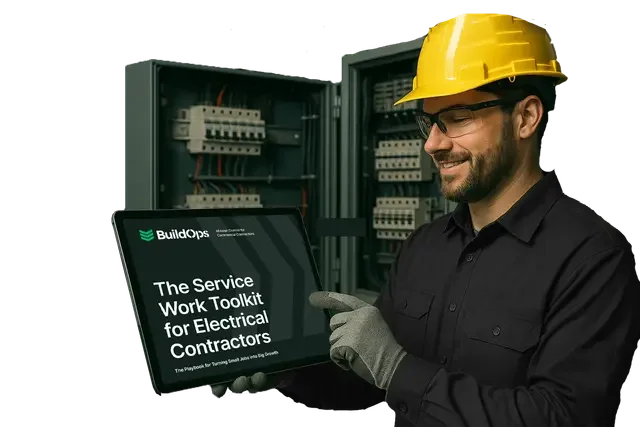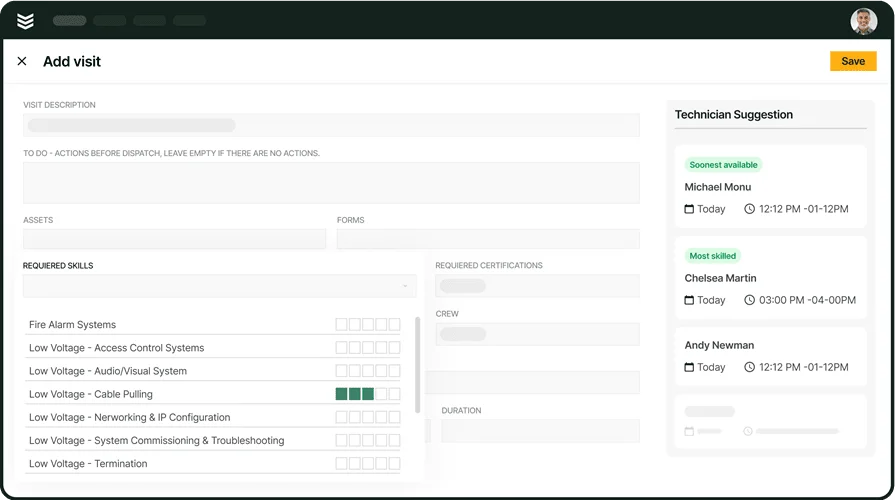Managing scheduled service for panels, breakers, lighting, and switchgear doesn’t leave much room for error. For commercial electrical contractors, routine maintenance isn’t a side gig—it’s a revenue engine. And when work orders pile up or compliance slips, it hits hard.
That’s where electrical maintenance software makes a difference. The right tool keeps your techs moving, your preventive maintenance on schedule, and your service records clean. From quarterly panel inspections to multi-property lighting PMs, electrical preventive maintenance software gives your team what they need to get in and out—without missed steps or wasted hours.
Whether you’re tracking load checks, testing breakers, or updating arc flash labels, a purpose-built platform keeps your whole crew aligned. If you work in the electrical industry, having a system that connects scheduling, dispatch, asset history, and job completion in one place is no longer a bonus—it’s essential.
Here’s what this guide covers:
- Choosing the right electrical maintenance software for your contractors
- 5 key features every electrical maintenance software should offer
- 7 best electrical maintenance software for contracting teams
- 7 real benefits of using electrical maintenance software
- 4 important FAQs about electrical maintenance platforms
Before you dive into picking tools, let’s talk about what your team really needs—and how the right system helps you prevent downtime, not just respond to it.
Choosing the right electrical maintenance software for your contractors
From breaker testing to service panel inspections, field work in the electrical industry relies on precision, speed, and strong coordination. One skipped PM, one delayed dispatch, and your entire day can go sideways.
Electrical maintenance software helps crews stay focused and ready. Whether you’re leading jobs across office parks, data centers, or campuses, the software you choose has to support every part of the work—recurring service, real-time updates, asset tracking, and load testing history. Choosing a platform that fits how your team actually works means fewer delays and a lot less rework.
Here’s what to look for before locking in any system for your field crew.
- Ease of use – Can your electricians pull up panel schedules or service logs while onsite without needing a manual? Can a tech update job notes from their phone without calling dispatch? Does the layout make sense for the field—not just office staff?
- Value for cost – Are you getting tools that cut down repeat work, or just features you’ll never use? Does it help your team reduce callbacks and speed up job completion? Does it tighten the loop between work done and jobs billed?
- System integration – Will it connect to your dispatch board, asset tracking software, or quoting tools? Can your current service records be imported without losing data? Does everyone—from project managers to field techs—see the same thing in real time?
- Support and protection – If a glitch hits during a live job, can you reach support fast? Is customer and job data backed up and secured? Are updates frequent enough to protect against bugs and breaches?
- Features – Can the system handle all your team’s field needs? Does it schedule recurring breaker inspections and track maintenance cycles by asset type? Can it log load readings, equipment photos, and checklist completion—all from the field?
Choosing electrical maintenance software without field input sets your team up for delays. These questions help surface what matters—because no tech wants to dig through bad menus when they’re elbow-deep in a live panel. Next, we’ll break down the five core features every electrical preventive maintenance software should actually deliver to keep your crew sharp and jobs on time.
5 key features every electrical preventative maintenance software should offer
Running field service in the electrical industry means balancing routine PMs, urgent service calls, and strict safety checks—all while managing multiple crews across different sites. The best electrical maintenance software simplifies that complexity. It gives your team tools they actually use in the field, connects every job from scheduling to invoicing, and keeps your operation moving without the guesswork.
Here’s what matters most when choosing a platform for recurring maintenance and field-driven electrical work.
1. Scheduling and dispatch built for the field
When your crew is handling load tests, breaker inspections, and annual PMs across properties, your software needs to do two things well—keep the schedule clean and keep the field moving. With field service scheduling tools, you can automate recurring PMs, stagger multi-building service cycles, and avoid manual calendar errors. And when plans shift mid-job, dispatch software lets you reassign techs based on proximity, availability, and license in real time.
Consider this: If your crew finishes a transformer inspection early and another site logs flickering lights, you can redirect a nearby tech in seconds—without a call or delay.
2. Service history and asset tracking
Every job is smoother when your techs know the history. Electrical CRM software gives your team access to panel records, test results, past notes, and flagged issues—on demand. That kind of detail turns PMs into proactive work, not just box-checking.
For example, before starting a preventive maintenance job on a rooftop disconnect, your tech can check torque test results from last quarter and verify if past overheating issues were resolved or still at risk.
3. Mobile documentation that works in the field
Techs should be able to complete their work without a laptop or office call. A technician mobile app for electrical service puts job checklists, service logs, photo uploads, and close-out steps directly on their phone. It saves time, tightens documentation, and supports fast handoffs between field and office.
For example, during a lighting inspection at a multi-tenant facility, your crew can log fixture failures, snap replacement photos, and mark completion before leaving the jobsite.
4. Invoicing and payment tied to job completion
Billing should match the job, not lag behind it. Electrical invoicing software creates invoices based on completed service, and payment tools track what’s received and what’s still pending. It gives your office a clear view of field performance and cash flow without chasing paperwork.
Say after a quarterly PM visit wraps at a logistics hub, the invoice gets generated and sent that same day—linked to checklists, labor hours, and service notes.
5. On-the-spot quoting for service findings
PM work often uncovers issues. Electrical quoting software helps techs generate and send estimates from the job, reducing delays in getting approval for follow-up work. Quotes can include parts, labor, and supporting photos—all from the field.
Imagine, if your tech finds a cracked bus bar or rusted neutral lug during routine panel maintenance, they can build the quote on the spot and get it in the customer’s hands before leaving.

Service Agreement & Maintenance tracking
Built in to BuildOps to completely automate your service calls.
Other notable features for electrical crews
While not every feature is critical to running daily service jobs, the best electrical maintenance software still offers added tools that give contractors better control, deeper insights, and cleaner workflows. These value-adds may not be essential for every team—but when used right, they improve how electrical preventive maintenance gets tracked, measured, and scaled across multiple properties.
- Time Tracking - Time tracking tools help crews log labor hours directly from the field, giving your office accurate job costing, payroll data, and visibility into technician efficiency. It’s especially useful when juggling multiple service calls or phased PM work.
- Reporting and Job Analytics - With reporting software, contractors can track PM trends, technician productivity, equipment failure rates, and contract profitability. These reports help teams make smarter decisions on staffing, quoting, and when to replace aging assets.
- Service Agreement Management - Service agreement tools keep contract details, visit intervals, and compliance requirements organized in one system. They also automate reminders and link directly to billing once the PM is complete.
- Pipeline Visibility - Pipeline software gives electrical contractors a live view of job progress across leads, quoted work, approved service, and completed maintenance—helping office teams manage workflow without relying on scattered emails or spreadsheets.
- Fleet Management - Fleet tracking tools offer real-time GPS visibility of service vehicles, route optimization, and vehicle health tracking. These features help dispatch teams cut drive time, plan efficient routes, and reduce unplanned downtime for field crews.
These features may not be part of your day-one rollout, but when your business starts handling dozens of PM contracts or running multi-crew service ops, they can bring structure, speed, and clarity to how you operate.
7 best electrical maintenance software for contracting teams
There’s no shortage of tools out there promising to help electrical contractors manage service and maintenance. While some platforms specialize in asset management or job tracking, others aim to provide broader support across service delivery. Here are a few standout options in the electrical maintenance software space—along with the trade-offs to keep in mind before making a decision.
1. Best for commercial electrical contractors: BuildOps
For commercial contractors handling PMs across healthcare, education, industrial, and office facilities, BuildOps delivers electrical maintenance software platform that prioritizes field performance and preventive upkeep specifically built for commercial contractors. It organizes recurring work, assigns the right tech for each job, tracks asset history, and provides real-time updates across every crew in the field—all without bouncing between disconnected systems.
Whether it’s managing long-term maintenance agreements or dispatching teams across multiple service zones, BuildOps helps keep schedules tight and compliance deadlines met.
How pricing works: BuildOps offers tailored pricing based on user count, features, and contract scale—ideal for teams that want flexibility over fixed bundles.
Features beyond maintenance scheduling:
- Real-time dispatch and workload visibility
- Automated preventive maintenance task lists
- Service agreement management and reminders
- Full job history and performance reporting
What sets it apart for commercial teams: BuildOps is focused specifically on field service contractors with complex, multi-property PM work. It gives operations leads and dispatchers control over service schedules, maintenance checklists, job statuses, and field team routing—all in one tool, purpose-built for commercial electrical work.

Take a closer look at BuildOps
We help electricians with scheduling, dispatch, and asset tracking—from one place.
2. Best for residential electrical contractors: ServiceTitan
Image Source: ServiceTitan
ServiceTitan supports residential electrical contractors with tools for customer communication, scheduling, invoicing, and technician tracking. It’s known for mobile job management and real-time status updates, giving homeowners transparency during service calls. Its strengths lie in booking, quoting, and follow-up workflows—helping techs move efficiently from job to job. However, contractors focused heavily on electrical preventive maintenance may find ServiceTitan lacking when it comes to advanced recurring job tools and asset-level maintenance tracking.
How pricing works: ServiceTitan offers custom pricing based on the number of users and tools selected. Quotes vary widely depending on company size and scope.
Features beyond maintenance management:
- Integrated customer messaging and call tracking
- Mobile invoicing and estimate generation
- Job performance dashboards and analytics
- Automated technician dispatching
What sets it apart for residential teams: It’s built for quick response work, with an interface designed around simple, repeatable service visits. The tech-facing app and customer engagement tools make it easier to manage short-duration jobs and one-time repairs.
3. Best for general electrical contractors: Jobber
Image Source: Jobber
Jobber is designed for contractors juggling quoting, invoicing, scheduling, and general service work across various industries. It’s simple to use and supports core tasks like calendar booking, route planning, and invoice collection. Jobber’s asset management features are limited, but it works well for small teams that want a clean, all-purpose solution without deep customization. Contractors managing long-term PM contracts or detailed service agreements may outgrow Jobber’s feature set when scaling recurring electrical maintenance.
How pricing works: Jobber runs on a tiered pricing model based on users and available features. Costs are clear, but options can feel restrictive as your service demands grow.
Features beyond maintenance management:
- Task and visit tracking across job sites
- Centralized customer database
- Custom quoting templates and simple follow-ups
- Invoice tracking and online payments
What sets it apart for general teams: Jobber’s clean interface and straightforward tools make it a solid choice for new or growing contractors handling basic service work. It fits well for those who need electrical maintenance software that gets the job done without overcomplicating the process.
4. MPulse Software
Image Source: MPulse
MPulse is tailored specifically toward maintenance-heavy industries, offering advanced features for asset tracking, PM scheduling, and historical performance reporting. It excels in environments where equipment reliability is mission-critical, making it a solid pick for contractors working in manufacturing or facility management with strict inspection schedules. However, MPulse is geared more toward plant-based teams than mobile field service crews, and the interface may feel too complex for electricians focused on real-time scheduling and dispatching.
How pricing works: MPulse follows a tiered pricing structure based on modules and user needs, with options that scale from small teams to large enterprise-level setups.
Features beyond maintenance management:
- Asset lifecycle management and service tracking
- Calendar-based and meter-based PM triggers
- Historical job reporting and audit trails
- Inventory control and purchasing workflows
What sets it apart: MPulse focuses heavily on compliance, uptime tracking, and detailed maintenance history, making it a solid tool for teams prioritizing long-term equipment reliability over daily service call management.
5. FieldInsight
Image Source: FieldInsight
FieldInsight is built with field service contractors in mind, offering scheduling, quoting, and job tracking within a single platform. It supports basic maintenance workflows and helps keep teams organized with real-time updates and technician visibility. FieldInsight also includes job notes, task checklists, and GPS tracking. That said, its feature set around electrical preventive maintenance is limited, and some users may find it lacks the depth needed for more advanced PM tracking or recurring contract management.
How pricing works: FieldInsight offers subscription pricing based on tiers, which include access to varying levels of automation, reporting, and user permissions.
Features beyond maintenance management:
- Job scheduling and dispatch
- Customer history and job notes
- Quoting and invoice tools
- Basic task tracking and team visibility
What sets it apart: FieldInsight stands out for its straightforward user interface and mobile-friendly design, making it useful for smaller teams looking for easier field coordination without too many extras.
6. Simpro
Image Source: Simpro
Simpro is a robust field service platform that supports project-based electrical contractors. It covers quoting, scheduling, job costing, and asset management. Simpro is best suited for teams that balance planned maintenance with installs or project work, offering tools to manage both types of jobs side by side. Still, its heavy focus on project features may overshadow the needs of electrical service teams looking for lean, service-specific electrical maintenance software.
How pricing works: Simpro uses a custom quote model depending on your team size and feature stack, with modular pricing that adapts to specific workflows.
Features beyond maintenance management:
- Asset registers and recurring service scheduling
- Job costing and inventory tracking
- Multi-stage quoting for large contracts
- Project budgeting and reporting tools
What sets it apart: Simpro offers deep customization for teams balancing install work and maintenance. It’s a strong fit for businesses that need full project management alongside field service tools.
7. Service Fusion
Image Source: Service Fusion
Service Fusion supports small to mid-sized electrical contractors with scheduling, dispatching, and customer communication tools. It includes mobile invoicing, quote management, and a client portal for tracking service calls. Its ease of use and simple interface make it appealing for teams focused on fast turnaround jobs. However, it may fall short for contractors who rely heavily on detailed asset histories or robust electrical preventive maintenance scheduling features.
How pricing works: Service Fusion offers transparent pricing tiers with flat monthly rates based on user limits and available modules.
Features beyond maintenance management:
- Drag-and-drop scheduling and dispatch
- Customer portals and communication tracking
- Estimate and invoice creation
- Mobile app for tech updates and job logs
What sets it apart: Service Fusion is easy to onboard and navigate, making it a great pick for growing teams that want to tighten up scheduling and customer service without diving into a complex system.

Get the Electrical Contractor Toolkit
Manage field teams, track job progress, and stay ahead of maintenance cycles.
7 real benefits of using electrical maintenance software
Electrical service work moves fast—especially when you're managing preventive maintenance contracts, multiple technicians, and complex assets across job sites. The best electrical maintenance software gives your team more than digital checklists or scheduling tools. It delivers clear advantages that affect how you run jobs, handle customer relationships, and grow service revenue.
Here’s what you actually gain when using electrical preventive maintenance software built for field service teams.
1. Fewer missed appointments and double bookings
With optimized calendar views and automated job triggers, maintenance software reduces schedule conflicts and keeps recurring PMs on track. You avoid the scramble of rescheduling missed inspections or accidentally stacking multiple crews on the same site. This is especially true when using tools like this electrical contractor scheduling app that help teams plan preventive tasks around team availability and asset access windows.
2. Faster technician dispatching when priorities shift
When a tech finishes early or an urgent service call pops up, dispatch teams need to respond fast. Electrical preventative maintenance software gives dispatchers visibility into crew status, job progress, and current locations—so you can shift resources without a call chain or delay. That’s where electrical dispatch software comes into play, helping field supervisors quickly reassign work based on who’s closest and what skill sets are required.
3. Better job costing across preventive maintenance contracts
With detailed tracking of labor hours, materials, and job timelines, contractors can identify which PM contracts are profitable—and which ones are draining resources. You get the data to refine quoting, plan technician routes smarter, and address cost overruns early. Understanding these numbers starts with having the right electrical cost estimating tools that work in sync with your maintenance workflows.
4. Easier invoicing tied to completed PMs
Billing doesn’t have to lag behind the job. Electrical maintenance software helps trigger invoices automatically when jobs are marked complete—especially useful for recurring PMs where contract terms and service intervals are pre-defined. You can dig deeper into how top-performing teams manage this in our electrical contractor invoicing guide, which covers how service visits and billing cycles can stay aligned.
5. Less downtime across recurring service jobs
When preventive work is scheduled and executed on time, your teams catch problems early—avoiding shutdowns, fines, and emergency dispatches. Electrical preventive maintenance software keeps task lists in sync and job history transparent, helping techs flag issues before they become failures. It also allows teams to tie PM frequency and task priority back into planning with tools like this project management software for electrical contractors that support long-term planning and asset management.
6. Consistent service quality across crews
With standardized checklists, templates, and asset records, you reduce the risk of inconsistent work across teams. New hires and veteran techs alike follow the same PM workflows—keeping the quality high regardless of who’s assigned. This helps contractors scale their electrical preventive maintenance work without sacrificing accuracy or risking code violations.
7. Centralized data for better decision-making
Instead of scattered notes, spreadsheets, and paper reports, electrical maintenance software puts all job data in one place. You get better insight into what’s working, what’s overdue, and which properties or assets need attention. That data helps guide operational decisions, staffing plans, and even upsell opportunities tied to contract renewals or equipment upgrades.
4 important FAQs about electrical maintenance platforms
Electrical teams handle a range of tasks beyond service calls. They manage long-term maintenance contracts, monitor asset performance, and coordinate technicians across various locations. Therefore, the electrical preventative maintenance software you select must function effectively wherever you operate, whether you're in the office establishing service agreements or in the field completing a preventative maintenance checklist.
Here are four crucial questions contractors frequently consider when assessing platforms built for maintenance and service tasks.
1. What is electrical maintenance software?
Electrical maintenance software helps contractors schedule, manage, and track recurring service jobs like breaker inspections, panel testing, load verifications, and lighting PMs. These platforms streamline preventive tasks, reduce manual paperwork, and organize service history in one system.
Beyond job tracking, most software options support technician dispatch, automated task scheduling, customer communication, and invoicing—creating a connected workflow between office staff and field teams. It gives electrical crews real-time insight into what needs to be done, where, and by whom.
2. How do electrical maintenance apps work for field teams?
Most platforms offer mobile access through a technician app or browser login. These apps allow techs to view assigned jobs, follow step-by-step maintenance tasks, add notes, complete checklists, and upload photos—all while onsite. Job updates sync automatically with the office, keeping everyone on the same page.
This ensures that preventive maintenance work is documented consistently and reduces the chance of missed steps, miscommunication, or data entry errors after the fact.
3. Can electrical preventative maintenance software handle service agreements?
Yes—professional-grade tools are designed to support recurring service agreements. They manage contract terms, automate visit schedules, send out PM reminders, and keep track of milestone completions. Both techs and office staff can see what’s due and when—keeping your team ahead of deadlines and your clients informed.
This is especially important for electrical preventive maintenance software that supports multi-site clients or long-term contracts where compliance and accountability matter.
4. What are the best practices when using electrical maintenance software?
Using the platform well makes a big difference. Here are 10 straightforward best practices electrical contractors should follow when rolling out or upgrading their maintenance system:
- Standardize PM checklists so every tech follows the same workflow
- Keep asset records updated with detailed service history and photos
- Use recurring job templates to avoid creating repeat visits from scratch
- Train techs on mobile tools so updates are done in the field, not after
- Schedule PMs by building or zone to reduce travel time between jobs
- Set reminders for expiring contracts to avoid service gaps or lapses
- Track job completion times to spot delays or process breakdowns
- Connect invoicing to service so jobs get billed the same day they’re done
- Audit service logs monthly to make sure nothing slips through
- Use reporting tools to improve how teams are assigned and scheduled
When electrical maintenance software is used consistently across your operation, it helps you move faster, reduce mistakes, and keep long-term clients happy.
Preventive maintenance is a core part of how electrical contractors protect systems, meet deadlines, and grow their service business. Whether you're managing multi-building PMs, tracking arc flash compliance, or juggling emergency calls between scheduled visits, the software you choose needs to handle all of it without slowing your crew down.
The best platforms don’t just digitize your workflow—they simplify how you manage teams, track work, and keep recurring jobs under control. And for commercial contractors especially, having everything in one system—dispatch, scheduling, asset logs, agreements, and invoicing—makes the difference between fighting fires and staying ahead of them.
All-in-one platforms like BuildOps are built with commercial field service in mind. They’re designed to support the pace and complexity of real electrical service work, not just one-off fixes.

Curious how BuildOps works?
We help electricians manage jobs from the first call to the final invoice.








